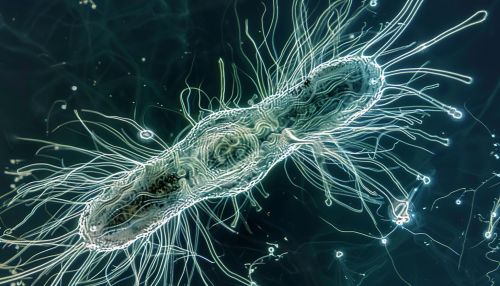Heterokont
Introduction
The term "heterokont" refers to a diverse group of eukaryotic organisms characterized by the presence of two distinct types of flagella. These organisms are also known as stramenopiles, a name derived from the Latin words "stramen" (straw) and "pilus" (hair), which describe the unique structure of their flagella. Heterokonts encompass a wide range of organisms, including algae, diatoms, and oomycetes, and play significant roles in various ecological and biological processes.
Taxonomy and Classification
Heterokonts belong to the kingdom Chromista, which is part of the larger supergroup SAR. The SAR supergroup is a major lineage of eukaryotes that also includes alveolates and rhizarians. Within the Chromista kingdom, heterokonts are classified into several major groups, including:
- Ochrophyta: This group includes various types of algae, such as brown algae (Phaeophyceae), golden algae (Chrysophyceae), and yellow-green algae (Xanthophyceae).
- Bacillariophyta: Commonly known as diatoms, these are unicellular algae with silica cell walls.
- Oomycota: Also known as water molds, this group includes many plant pathogens, such as Phytophthora infestans, the causative agent of the Irish potato famine.
Morphology and Structure
One of the defining characteristics of heterokonts is the presence of two distinct types of flagella: a smooth, whiplash-type flagellum and a tinsel-type flagellum with lateral hairs called mastigonemes. These flagella are typically located at the anterior end of the cell and are used for locomotion.


The cell structure of heterokonts varies widely among different groups. For example, diatoms have intricate silica cell walls called frustules, while brown algae have complex multicellular structures with specialized tissues.
Photosynthesis and Metabolism
Many heterokonts are photosynthetic and possess chloroplasts derived from secondary endosymbiosis with a red alga. These chloroplasts contain chlorophylls a and c, as well as accessory pigments such as fucoxanthin, which gives brown algae their characteristic color. Photosynthetic heterokonts play a crucial role in aquatic ecosystems as primary producers.
Non-photosynthetic heterokonts, such as oomycetes, obtain nutrients through heterotrophic means. Oomycetes are known for their saprophytic and parasitic lifestyles, often infecting plants and animals.
Ecological Roles and Importance
Heterokonts occupy diverse ecological niches and contribute significantly to various ecosystems. Photosynthetic heterokonts, such as diatoms and brown algae, are essential components of marine and freshwater phytoplankton communities. They are primary producers, forming the base of the food web and supporting a wide range of marine life.
Diatoms, in particular, are known for their role in the global carbon cycle. They sequester carbon dioxide through photosynthesis and contribute to the formation of marine sediments when they die and sink to the ocean floor.
Oomycetes, on the other hand, are important decomposers and pathogens. They play a role in nutrient cycling by breaking down organic matter. However, some oomycetes are notorious for causing devastating plant diseases, such as downy mildew and root rot.
Evolution and Phylogeny
The evolutionary history of heterokonts is complex and involves multiple endosymbiotic events. The acquisition of chloroplasts through secondary endosymbiosis with a red alga is a key event in the evolution of photosynthetic heterokonts. This endosymbiotic relationship has led to the diversification of heterokonts into various photosynthetic lineages.
Molecular phylogenetic studies have provided insights into the relationships among different heterokont groups. These studies have revealed that heterokonts are closely related to other members of the SAR supergroup, such as alveolates and rhizarians. The phylogenetic relationships within the heterokonts themselves are still an active area of research, with ongoing efforts to resolve the evolutionary history of this diverse group.
Genomics and Molecular Biology
The genomes of several heterokont species have been sequenced, providing valuable insights into their biology and evolution. For example, the genome of the diatom Thalassiosira pseudonana was one of the first algal genomes to be sequenced. Genomic studies have revealed unique features of heterokont genomes, such as the presence of genes acquired through horizontal gene transfer from bacteria and other eukaryotes.
Molecular biology techniques have also been used to study the regulation of gene expression in heterokonts. For instance, research on the model diatom Phaeodactylum tricornutum has uncovered regulatory mechanisms that control photosynthesis, nutrient uptake, and stress responses.
Biotechnology and Applications
Heterokonts have significant potential for biotechnological applications. Diatoms, with their intricate silica cell walls, are being explored for use in nanotechnology and materials science. The unique properties of diatom frustules make them suitable for applications such as biosensors, drug delivery systems, and photonic devices.
Brown algae, such as Laminaria and Macrocystis, are harvested for their alginates, which are used as thickening agents in the food and pharmaceutical industries. Alginates are also used in wound dressings and tissue engineering due to their biocompatibility and gel-forming properties.
Oomycetes, despite their role as plant pathogens, have also been studied for their potential in biocontrol. Certain oomycetes produce antimicrobial compounds that can be used to control plant diseases and pests.
Challenges and Future Directions
Despite the progress in understanding heterokonts, several challenges remain. The complexity of their life cycles, the diversity of their ecological roles, and the intricacies of their evolutionary history present ongoing research questions. Future studies will likely focus on unraveling the molecular mechanisms underlying their unique features, exploring their ecological interactions, and harnessing their biotechnological potential.
Advances in genomics, transcriptomics, and proteomics will continue to provide new insights into the biology of heterokonts. Additionally, the development of new molecular tools and techniques will enable researchers to manipulate heterokont genomes and study their functions in greater detail.
See Also
- Chromista
- SAR (Stramenopiles, Alveolates, and Rhizaria)
- Ochrophyta
- Bacillariophyta
- Oomycota
- Thalassiosira pseudonana
- Phaeodactylum tricornutum
- Laminaria
- Macrocystis
